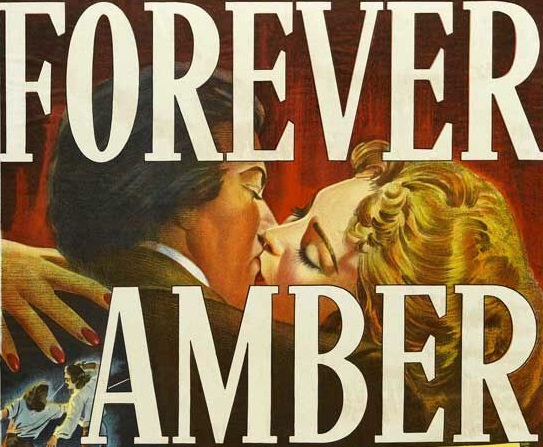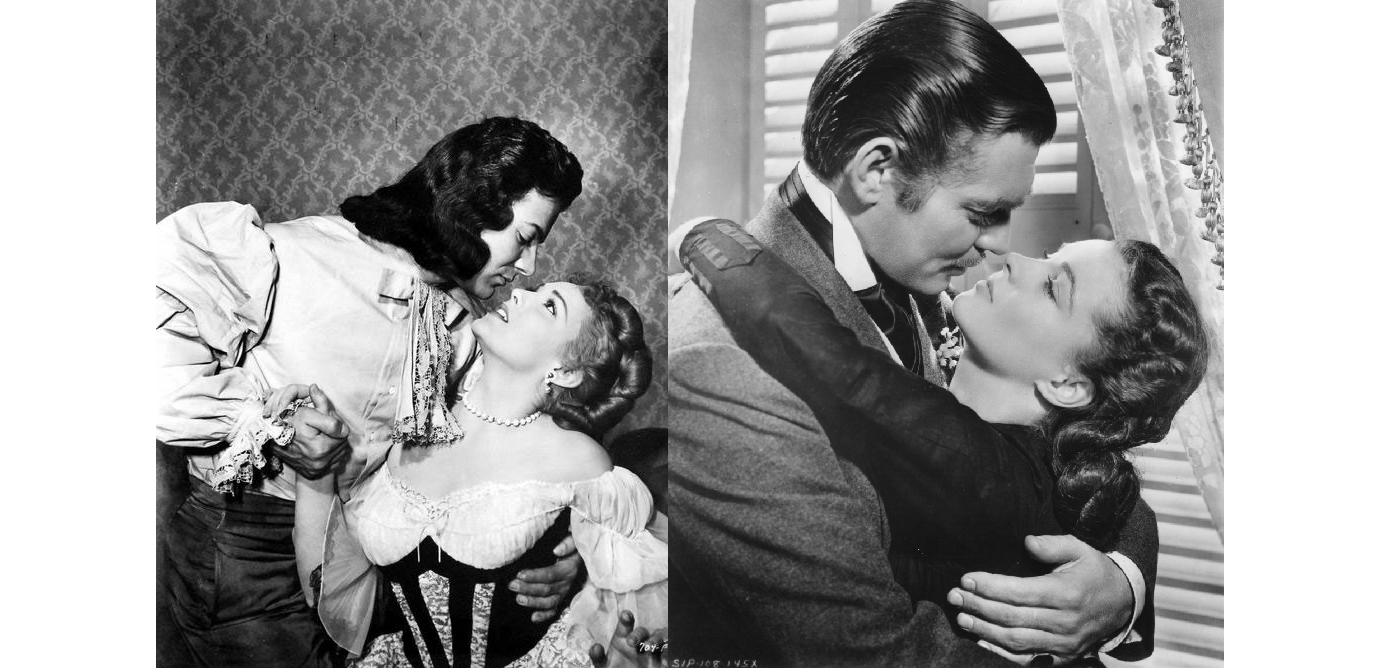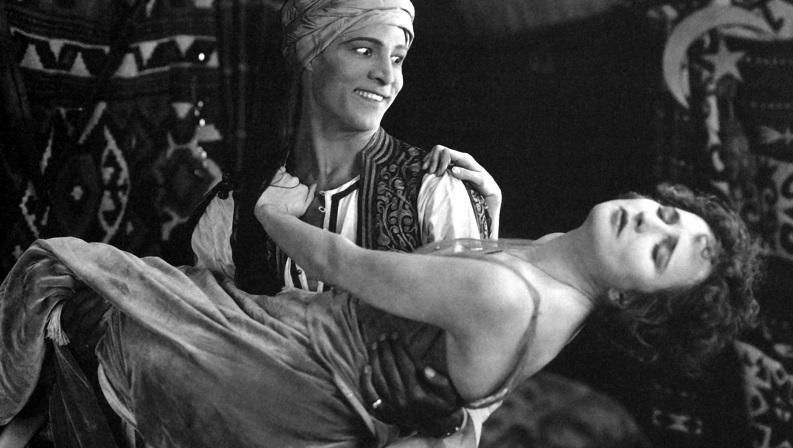A country maid sleeps her way to duchess status, but never manages to attain a happy ever after with her favorite lover.
Book details
Title: Forever Amber
Author: Kathleen Winsor
Original publication date: 1944
Setting time & place: 1660s, Restoration England
He is… an earl and privateer, mid-thirties.
She is… a 16 year old country maid determined to find a better life.
Reasons to read this title: Your teenage grandmother read it after hearing a sermon at church about how corrupt it was. Also, Restoration London is a sybaritic period not often visited by genre romance.
My review of Forever Amber
Is it a romance novel? No. The book breaks two rules of genre romance: it has no happy ending (some may say no ending at all) and both heroine and hero engage in rampant cheating.
Is it a must read romance novel? Readers who enjoy historical romance for the glimpses of historical eras they provide may still enjoy Amber’s story for the research Winsor put in.
I’ve written previously about why I put Forever Amber on my reading list, and discussed similarities between Winsor’s book and earlier read Gone With the Wind, but let me give you the quick run down of this epic historical novel. Fair warning, I’m giving all the spoilers.
Start scrolling if you don’t want spoilers!
We meet Amber St. Clare as a young country maiden who meets — and immediately gets the hots for — aristocrat Bruce Carlton, an earl returning from France with King Charles II as monarchy is restored to the country. Bruce is willing to sleep with her and bring her to London as his mistress, but not to marry her.
Once Amber is pregnant, Bruce is off to America and Amber is duped into marriage and out of the money he’s left her by a conman. Debts land her in Newgate prison, from which she is sprung by a highwayman, who takes her as a mistress. She gives birth to Bruce’s son, and the baby is sent to a country wetnurse. The highwayman is caught and strung up; Amber moves in with a dissolute scholar instead, who helps her get a place as an actress. Scholar’s dad comes to lay down the law, but she’s just managed to steal a well-to-do soldier, Captain Morgan, from a rival actress and engage herself as his mistress.
She catches the eye of the king and sleeps with him a few times, arousing the jealousy of Captain Morgan. Then Bruce comes back to town and she meets with him. Captain Morgan challenges Bruce to a duel and is killed by him; Bruce leaves again. Amber has an assignation with the Duke of Buckingham, but only once because he introduces her to “perversion.”
Her money from Captain Morgan is running out, so she leaves town and manages to meet a wealthy merchant. After nursing him back to health from a well-timed poisoning (hmm…), she marries the merchant and plays the virtuous woman for his family while also cuckolding him with Bruce, who’s back long enough to get both Amber and her step-daughter Jemima pregnant. The rich merchant dies, leaving Amber with a last name for her second child and a very generous amount of money.
The money’s not enough to tempt Bruce into matrimony, however, and she next marries the elderly, impotent and nasty Earl of Radclyffe, who confines her at his country estate after presenting her at court and realizing she’s going to sleep with the king again the first chance she gets. She gets her revenge by sleeping with his son; the elder Radclyffe attempts to poison them both but only manages to kill his heir. Whoops! Amber and a loyal manservant chase him to London, which happens to be on fire, providing a nice cover for the Earl’s death.
Rich, titled, and unencumbered by any husbands, Amber returns to court to sleep with the king. The plague comes to London, but so does Bruce, so no way is Amber leaving. Her faithful maidservant takes the kids out of town while Amber nurses Bruce through the plague. Then he nurses her and they’ve been through a lot together… but he’s still not going to marry her. He takes their son to America with him. Amber goes back to court and her royal mistress position, and gets pregnant again. She’s had several abortions and really only wants Bruce’s children, but having the king’s kid is a good way to ensure her position.
The only hitch is that the king insists she get married again for appearance’s sake and she ends up with meddling mother-in-law who wants to a) spend Amber’s money and b) sleep with Bruce, so Amber has to marry her off and set up her new husband’s mistress just to get some peace in her home life. She also convinces the king to make her a duchess, which doesn’t make the other ladies of the court like her any better.
Then Bruce is back and not only is he not going to marry her, he’s married some young beauty from colonial Jamaica, Now his wife is the sensation at court and everyone knows that Amber’s in love with him and it’s basically humiliation galore. Bruce makes a vague attempt to break up with Amber, because he loves his wife, but he just can’t keep his pants on with Amber in the room. She is unwilling to take no for an answer, which makes her an easy target for political strategists who’d like her (and her influence on the king) out of the picture: she’s informed that Bruce’s wife died suddenly while travelling and immediately packs her bags to follow “widowed” Bruce to America.
And that’s the end of the book. What happens when she gets to America? There’s no sequel, so ????
Okay, you can stop scrolling. That was the whole plot summary.
The whole of Forever Amber is basically a soap opera. Amber develops very little emotionally, though she does become savvy about her finances. But the whole story is a repeated cycle of “Amber sleeps with a man who is useful to her advancement, and also with Bruce Carlton.”
Forever Amber is not a romance.
There’s no moment of “love conquers all,” let alone a happy ever after. It’s not a romance story, and therefore it makes little sense to try and analyze the book within the framing of the romance genre.
But… like Gone With the Wind, or Rebecca, Forever Amber is generally referred to as a romance novel. GWTW gets the label for its focus on a love story, and misses the genre definition for lack of a HEA. Rebecca, as I’ve discussed, may get the label for its similarities with Jane Eyre. So what makes the non-romance reader mistake Forever Amber for a romance?
I believe it’s because the book conforms to the common misconception that romance novels are all about sex: “mommy porn.” And, to the distress of the good people of Boston and great many others when Forever Amber came out, Amber is not at all shy about sex. 70 references to sexual intercourse! 10 descriptions of women undressing in front of men! The book quite literally details Amber sleeping her way to the top.
Sex, yes. But love? Winsor is pretty cagey about the idea of love. Amber often says that she is desperately in love with Bruce, but other characters and the narrative also claim she is equally in love with the king and with Bruce’s best pal Almsbury (who she also sleeps with, but I left out of the plot summary because he has very little affect on the plot). Bruce seems equally attached to his wife and to Amber. King Charles II is shown as loving his wife as well as his various mistresses, as well as his sister and his many children.
Amber liked Almsbury better for being Bruce’s friend; he liked her better for being his Lordship’s mistress and mother of his children. But not one of the three considered it either strange or disloyal that in Carlton’s absence the Earl sometimes made love to her.
Where the genre romance holds up the idea of one true love, Forever Amber comes very close to proposing that a state of reasonable happiness can be found with different partners for different purposes, if only the multiple partners could resist being desperately jealous of each other.
Amber is not just a sexually liberated woman: she is a woman for whom sex is the means of liberation.
For me, that’s the heart of what makes Winsor’s book remarkable. In the arc of genre history I’ve read so far (and I know I said Amber’s not part of the genre, but bear with me) it’s the first book which frankly acknowledges the heroine’s sexuality and revels in it. Amber makes a particularly stark contrast to Diana, the heroine of The Sheik, who began as a liberated woman but was subjugated by means of her sexuality. There’s just twenty-five years between the two books, each of which was titilating, scandalous, and widely-read, on the tip of the tongue for hundreds of cultural references despite being labeled as trashy.
Though I’m placing Forever Amber outside of the romance genre, I do believe that it is an important influence on the development of the genre, and that the readers who found it as teens during the fifties surely overlapped with those who enjoyed visiting Heyer’s vision of the Regency, and those who devoured Woodiwiss’s The Flame and the Flower when it appeared in 1972. I’d like to suggest that the romance genre develops to focus on heroines who find self-liberation through love and sex–so far in the Romance MFA readings we’ve seen heroines finding love and various levels of liberation (depending on the time period) but Winsor is the first major introduction of the element of liberation through sexual empowerment.
I look forward to seeing how these two strains come together as we continue forward through the history of the genre!




One Comment on “Kathleen Winsor’s Forever Amber: a sexually liberated heroine”
Comments are closed.